Dog blog
10 Best Dog Breeds For Families | Small & Large Dogs
Adding a dog to your life is a huge decision. You will have to consider several factors before choosing one, such as size, energy level, temperament, and more.
At the same time, bringing a dog into your family involves even more factors to consider, such as living conditions, the number of children, affordability, and almost everything that concerns the needs of your family members.
We know that choosing a dog breed compatible with all your family members can be quite difficult.
That’s why Ruff-Ruff has prepared a list of 10 of the best dog breeds for families to make your decision much easier.
1. Labrador Retriever
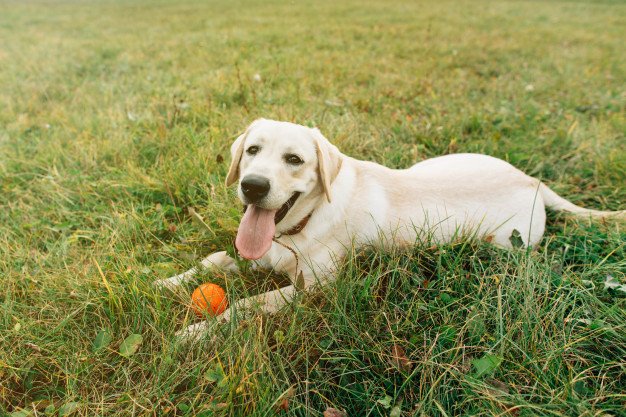
Temperament: intelligent, kind, active, loyal, gentle
Size: 22.5-24.5 inches & 65-80 pounds
Average lifespan: 10-12 years
Relationship with kids: ★★★★★
Relationship with other pets: ★★★★★
Energy level: ★★★★★
Adapting to apartment living: ★☆☆☆☆
✓ About The Breed
➡ Origins. The Labrador Retriever breed comes from the 17th century Newfoundland coast. The original purpose of these dogs was to pull fishing nets through the icy waters for fishers and, at the beginning of the 19th century, were brought to Poole Harbor in the UK, becoming an immediate success for hunting.
➡ Personality. The Labrador breed is definitely one of the best dog breeds for families – as long as your family members enjoy exercising and training along with them! They are friendly, tender, affectionate with everyone and certainly deserves their place in the top of the best dog breeds for families.
Moreover, they are versatile social dogs that quickly bond relationships with other animals and children, remaining patient and forgiving in any situation. They are incredibly loyal and love to part of all family life aspects. Labradors will bark to draw attention to strangers but will also greet them with warm welcomes.
➡ Exercise routine. If your family decides to adopt a labrador, keep in mind that they love long walks with the chance to run and play without a leash.
However, labradors will adapt quite quickly to the time you can allocate for their movement. Keep in mind that you should give them a reasonable period(a few hours a day are ideal for a healthy adult), and always be careful to provide them water, because it is essential for this breed’s exercise routine.
2. Golden Retriever
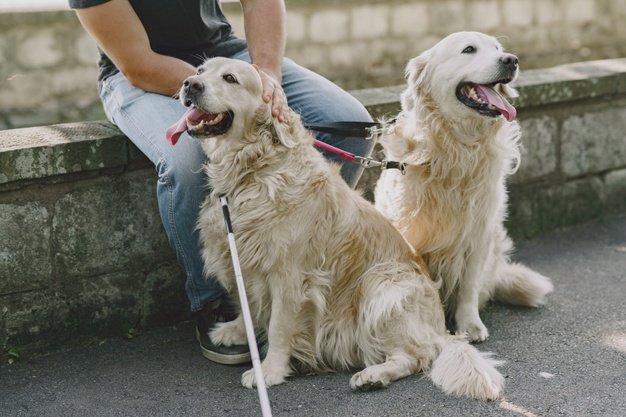
Temperament: intelligent, loyal, reliable, kind, trustworthy
Size: 21.5-24 inches & 55-75 pounds
Average lifespan: 10 – 12 years
Relationship with kids: ★★★★★
Relationship with other pets: ★★★★★
Energy level: ★★★★★
Adapting to apartment living: ★★☆☆☆
✓ About The Breed
➡ Origins. Sir Dudley Marjoribanks (Lord Tweedmouth) bought a dog named “Nous” from Brighton, England, in 1865, which he later mated with a female Tweedwater Spaniel, a dark red retriever. After 20 years of successive mating, the Golden Retriever breed was developed and presented as the Golden Flatcoats until 1913, when the name change to Yellow Retriever. Finally, in 1920, it received the name it still has today.
➡ Personality. Golden Retrievers are gentle dogs with a constant good mood and usually adapt very well to family life. They like to be involved in all activities, both at home and abroad, and are, above all, retrievers, meaning that they will regularly try to crawl, shoot or carry anything that fits in their mouth.
In addition, they like water, just like their Labrador brothers, so you need to make sure they are always near any form of water.
Moreover, Golden Retrievers are fighters, so you have to be very careful during their training, making sure you behave nicely with them at all times.
➡ Exercise routine. Golden adult Retrievers will require a lot of movement to keep them in the best shape. As long as they are puppies, make sure they are not overworked. Failure to do so may result in bone or joint problems. About two hours of training a day should be enough for adults, although these dogs will gladly accept more if you can offer them!
3. Beagle
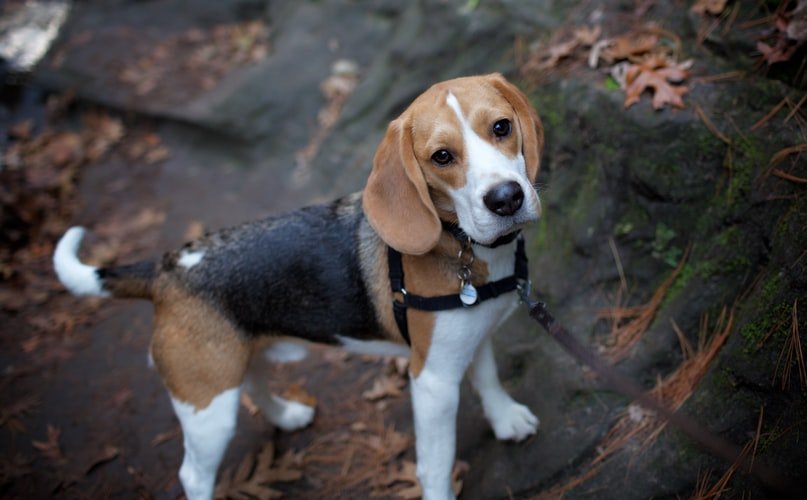
Temperament: even tempered, friendly, determined, easily-excitable, gentle
Size: 20-24 inches & 55-74 pounds
Average lifespan: 12 – 15 years
Relationship with kids: ★★★★★
Relationship with other pets: ★★★★★
Energy level: ★★★★☆
Adapting to apartment living: ★★★★☆
✓ About The Breed
➡ Origins. Greyhounds belonged to several categories according to their purpose around the middle of the 16th century, respectively greyhounds that hunt by sight, smell, speed, and more. At that time, a small greyhound, whose purpose was to kill domestic and wild rabbits, was called “Begles”, a French term that referred to the tendency of animals to shout and bark in their pack. The English version, of course, is “Beagle.” Therefore, this dog breed owes its origins to the Foxhound, Harrier, and a small cob known as the “Kerry Beagle”.
➡ Personality. Beagle dogs are usually very quiet and calm. Because they are used to live in the pack, they will get along well with most other dogs. They love children and they must come into contact with cats at an early age to develop good relationships with them. Beagle is a good watchdog, which barks at anything unusual, although once a potential thief enters your home, this dog may rather want to play with him!
➡ Exercise routine. The Beagle needs a lot of exercises – about two hours a day or more. Due to his strong hunting instinct, he must not be left on his own before he is very well trained to return to the signal; otherwise, you can only leave him in a fenced area. One way to keep your dog in good shape would be to let him exercise his natural talents by sniffing. Puppy field competitions are also popular among some Beagle owners.
4. Bulldog
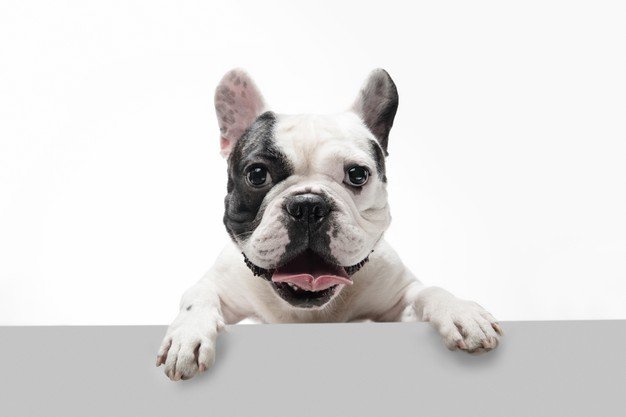
Temperament: docile, loyal, willful, kind, sociable
Size: 12-15 inches & 39-55 pounds
Average lifespan: 8 – 10 years
Relationship with kids: ★★★★★
Relationship with other pets: ★★★☆☆
Energy level: ★★☆☆☆
Adapting to apartment living: ★★★★★
✓ About The Breed
➡ Origins. Bulldogs come from the ancient breed Bullenbeissers, a mastiff-like dog used for attacking wild animals in Assyria, Greece, Egypt, and Rome. Bullenbeisser had various sizes. For example, in England, the original giant Bullenbeisser was modified to become a smaller dog. Thus, over the years, an ideal dog has been created for bullfighting. Fortunately, dogfighting was declared illegal in England in 1835. Since then, Bulldog owners began their selective breeding to eliminate the more aggressive elements of the breed and get a pet with a pleasant temperament.
➡ Personality. Being one of the best dog breeds for families, they love children and will even learn to get along well with other animals if you introduce them to it from an early age. The bulldog is a little too friendly to be a good watchdog, but he will defend his family members like a warrior when needed. He can be calm, thoughtful, funny, stubborn, and can have a well-developed sense of humor.
➡ Exercise routine. Bulldogs should not train on hot days. Two relatively short walks, at a steady pace but not too fast, should be enough. Unlike the other dog breeds shown above, bulldogs will love to sleep on the couch with their family instead of exercising for a few hours in the backyard.
5. Pug
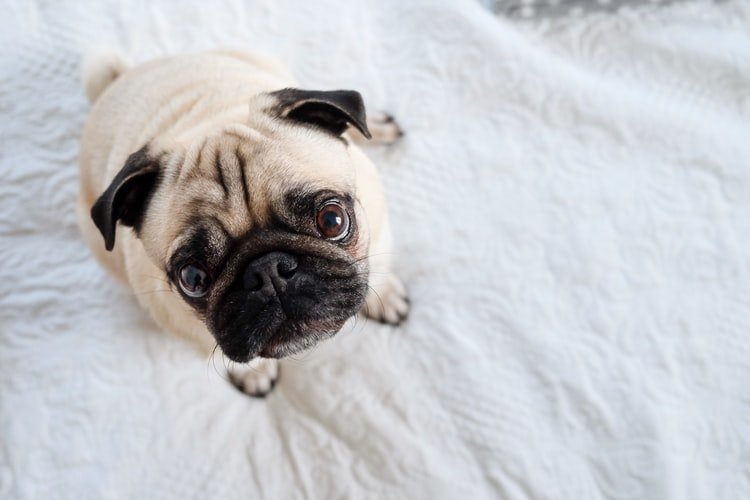
Temperament: playful, loving, stubborn, sociable, calm, quiet
Size: 9-14 inches & 55-79 pounds
Average lifespan: 12 – 15 years
Relationship with kids: ★★★★☆
Relationship with other pets: ★★★★☆
Energy level: ★★★☆☆
Adapting to apartment living: ★★★★★
✓ About The Breed
➡ Origins. With a long and remarkable history, the Pug came to China before accompanying merchants to Europe, where it developed as a breed in the Netherlands before the 16th century.
➡ Personality. This small and charming dog, with a gentle temperament, is a cheerful and sociable companion – and these qualities make it one of the best dog breeds for families. Pugs are dogs with strong personalities, being loved by the elderly and the young alike. They can be calm and quiet, but they can also have moments when they are disobedient and behave like a clown. Once integrated into a family, remember that she doesn’t like to stay separate from loved ones for too long.
➡ Exercise routine. Pugs only need about half an hour of exercise a day, but they will be happy to travel with you all day and accompany you wherever you are busy. Do not ask them to play in hot weather, and do not keep them in the car even when it is a little hot, as they may have difficulty breathing.
6. German Shepherd
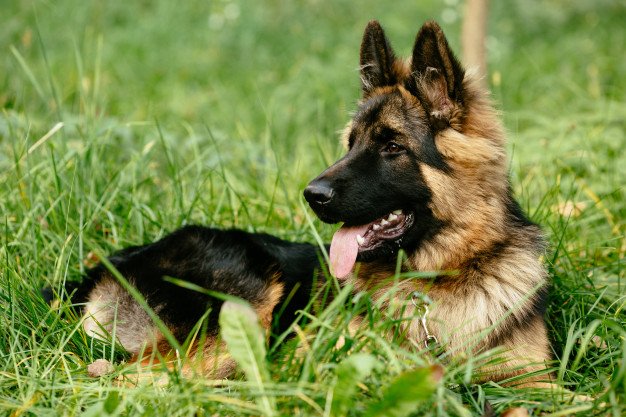
Temperament: intelligent, curious, stubborn, loyal, watchful
Size: 22-26 inches & 66-88 pounds
Average lifespan: 9 – 13 years
Relationship with kids: ★★★★★
Relationship with other pets: ★★☆☆☆
Energy level: ★★★★★
Adapting to apartment living: ★★★☆☆
✓ About The Breed
➡ Origins. The German Shepherd breed was originally raised to guide herds since the 7th century. During the First World War, the Germans used the German Shepherds as messenger dogs and to locate the wounded. Allied soldiers admired the intelligence and courage of these dogs and took many of them home after the war, spreading the popularity of this breed to other countries.
➡ Personality. The German Shepherd will have a very close relationship with his master and family and will want to be with them as much as possible. Although this breed does not require much attention, they will respond with loyalty and incorruptible guardian skills. On the other hand, if you do not make an effort to socialize and train a GSD, self-confidence and insubordination will arise. This dog is eager to learn and reacts very well to training, so he should be an eminent student in training classes.
➡ Exercise routine. You must gently train the German Shepherd puppy to avoid injury to their still soft and in formation joints. At the same time, an adult German Shepherd will need more than two hours of exercise daily in addition to multiple opportunities to use his intelligence during training or in thinking games.
7. Irish setter
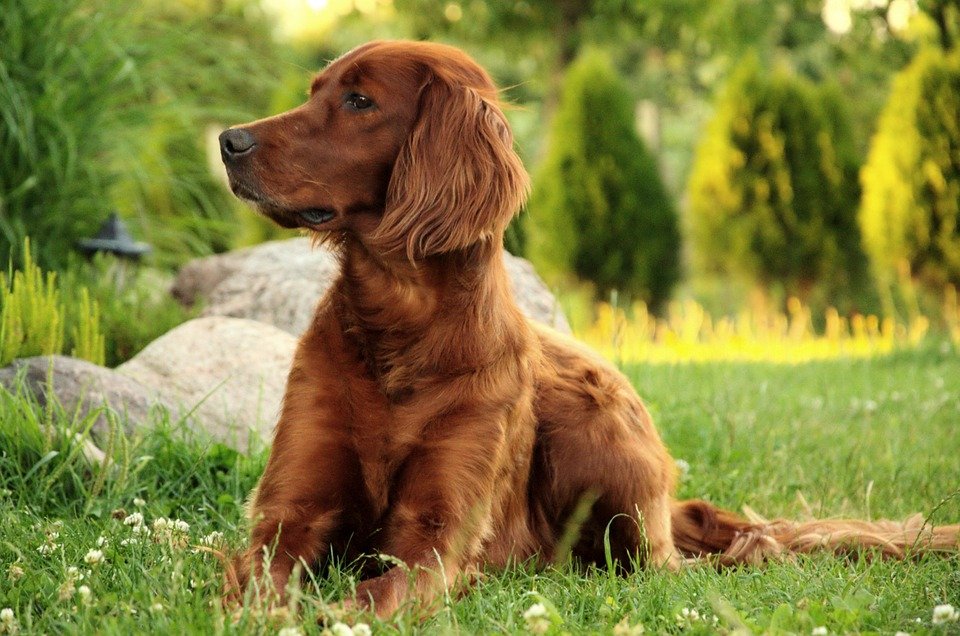
Temperament: companionable, playful, energetic, lively, loving
Size: 24-28 inches & 65-75 pounds
Average lifespan: 12 – 15 years
Relationship with kids: ★★★★★
Relationship with other pets: ★★☆☆☆
Energy level: ★★★★★
Adapting to apartment living: ★★★☆☆
✓ About The Breed
➡ Origins. The Irish Setter dogs are the oldest in the setter group, ahead of the Gordon Setter and the English Setter. This breed developed from the old Spaniels, Spaniard Setter, and Scottish Setter. In 1882 the Club of the Irish Red Setters was formed in Dublin, encouraged by the development program of the Earl of Enniskillen, who developed the characteristic red fur.
➡ Personality. The well-bred, well-socialized, and well-trained Irish Setter is an adorable and affectionate family pet. Early socialization with cats or other animals and close supervision are essential if you want to share the home with other pets. Being particularly friendly, it is not a good watchdog, although it will announce the presence of a visitor. The Irish Setter remains quite playful throughout his life – being one of his most pleasant features.
➡ Exercise routine. The Irish Setter is bred to hunt birds, so it is very active and needs a lot of movement – over two hours a day for an adult. Being a hunter, although easily distracted, he will follow the smells everywhere if he is not well trained to return to his family.
8. Collie
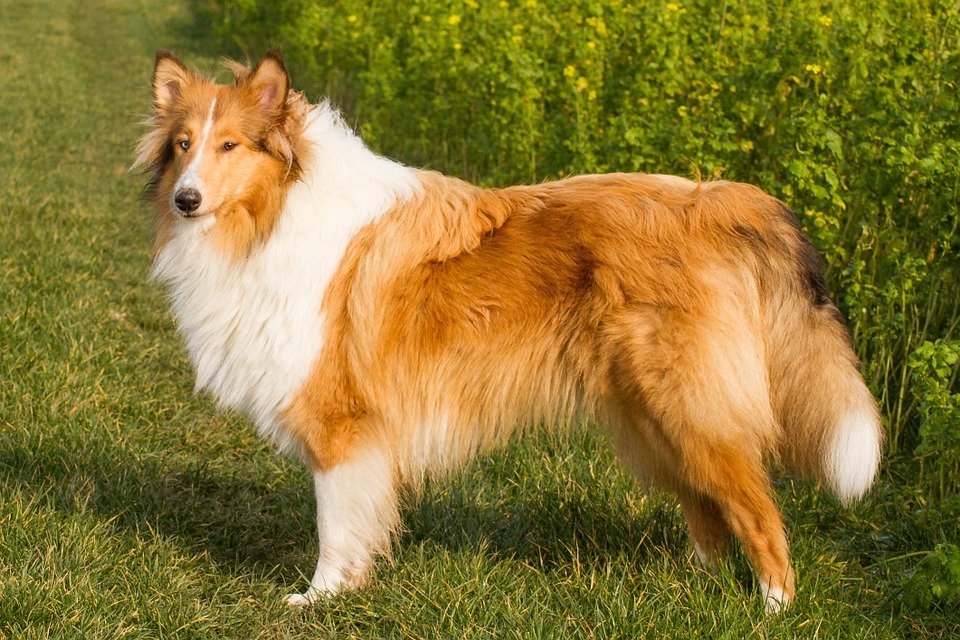
Temperament: intelligent, loyal, protective, friendly, active
Size: 26-32 inches & 50-70 pounds
Average lifespan: 12-15 years
Relationship with kids: ★★★★★
Relationship with other pets: ★★★★☆
Energy level: ★★★☆☆
Adapting to apartment living: ★★★☆☆
✓ About The Breed
➡ Origins. The long-haired Collie come from the companion dogs of Roman invaders in 50BC and from the native dogs of Scotland. Around 1860 Queen Victoria was enchanted by these dogs when she went to visit her Scottish estate at Balmoral and brought some with her to Windsor Castle. At that time, the breed name was “Scottish Shepherds”.
➡ Personality. The long-haired collie is friendly, with minimal evidence of nervousness or aggression. Collies are usually happy dogs who establish a very close bond with their families. Very protective of their home, they will warmly welcome the invited friends. Long-haired collies learn very quickly and are excited to take on new training challenges.
➡ Exercise routine. The long-haired Collie does not need much movement and will easily adapt to family circumstances. However, they must be allowed to run freely and play and retrieve a ball. An hour of exercise is enough for an adult, although he will gladly accept more if you can offer him.
9. Bernese Mountain Dog
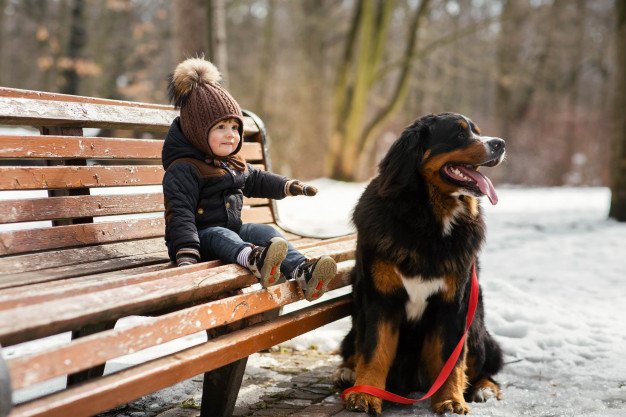
Temperament: intelligent, loving, loyal, faithful, brave
Size: 22-27 inches & 127-154 pounds
Average lifespan: 6 – 8 years
Relationship with kids: ★★★★★
Relationship with other pets: ★★★☆☆
Energy level: ★★★★☆
Adapting to apartment living: ☆★★★★
✓ About The Breed
➡ Origins. The Bernese Mountain Dog breed (or “Berner”) have a history of 2,000 years, when the Romans invaded Switzerland, then known as Switzerland, along with their cowboys and guard dogs. Roman mastiff dogs were probably crossed with herding dogs that could withstand the harsh weather in the Alps and also helped to tame their temperament. Berner Sennenhunds were then used to tow carts that transported fabrics or dairy products from one village to another
➡ Personality. Bernese Mountain Dogs have a pleasant temperament and love to be included in all aspects of family life, being wonderful companions. The reason why this dogs makes one of the best dog breeds for families is that they are loving, patient and especially gentle with children, protecting them if necessary. They need to be around people and receive affection, and they will bark to announce the arrival of visitors, but they will calm down quickly. If they socialize with cats and other pets in childhood they will always accept them.
➡ Exercise routine. When they are puppies, training should be restricted to allow the proper formation of bones and joints. After turning one year old, you can leave them without a leash in free-running training. As adults, Bernese Mountain Dogs usually need about an hour of daily exercise.
10. Border Collie
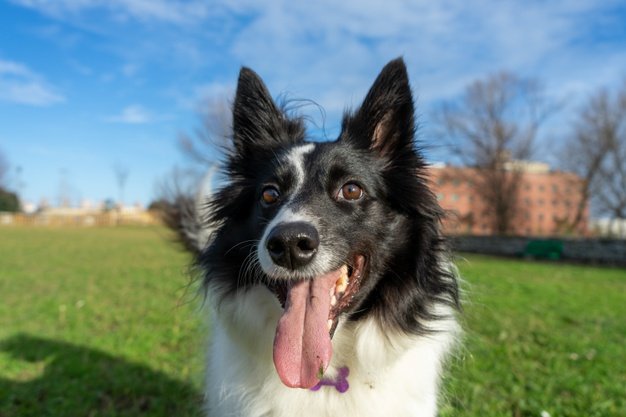
Temperament: intelligent, tenacious, active, tender, alert
Size: 18-22 inches & 26-44 pounds
Average lifespan: 10 – 17 years
Relationship with kids: ★★★★☆
Relationship with other pets: ★★★☆☆
Energy level: ★★★★★
Adapting to apartment living: ★★☆☆☆
✓ About The Breed
➡ Origins. The Border Collie breed dates back to the 1700s, although it did not receive its current name until 1915. Border Collies worked with shepherds on the border area between Scotland and England for hundreds of years, and they are mostly known for their ability to work hard along with humans.
➡ Personality. Border Collie dogs are always ready to work, attentive, lively, and alert. As a result, they will establish a very close relationship with their family. Still, if they don’t recieve enough time for training, they are not ideal pets for a family with very young children because it is in their nature to suspect any movement – including your children. Therefore, if you don’t keep them physically and mentally active, they will get bored, develop behavioral issues, or get in trouble because their minds are always active.
➡ Exercise routine. Given their constant need for activity and immense desire to please others, Border Collie dogs are delighted with training, which is a great way to activate their mind and body. They are a divine gift for those who want to compete in obedience, flyball, freestyle, herding, and other dog sports. Therefore, this is one of the best dog breeds for families if your family loves competitions.
The Bottom Line
As you can see, there are many dog breeds suitable for families. Some of them are more dynamic, others are child-friendly, and others are extremely intelligent and loyal. Therefore, depending on the number of family members, age, living conditions, and available time, you will surely find a dog that meets all your expectations.
We hope our list of best dog breeds for families has helped you find the right dog for your loved ones and we invite you to tell us in the comments below which of these is your favorite!


